Frijoles de la Olla
43
Updated Nov 02, 2024, Published Feb 07, 2020
This post may contain affiliate links. Please read our disclosure policy.
This Frijoles de la Olla recipe embodies everything you could possibly want from a side dish. These Mexican-style pinto beans are deliciously simple, budget-savvy, and endlessly versatile! Come along to my cocina—I’ll show you how to make them on the stove or in the Instant Pot.
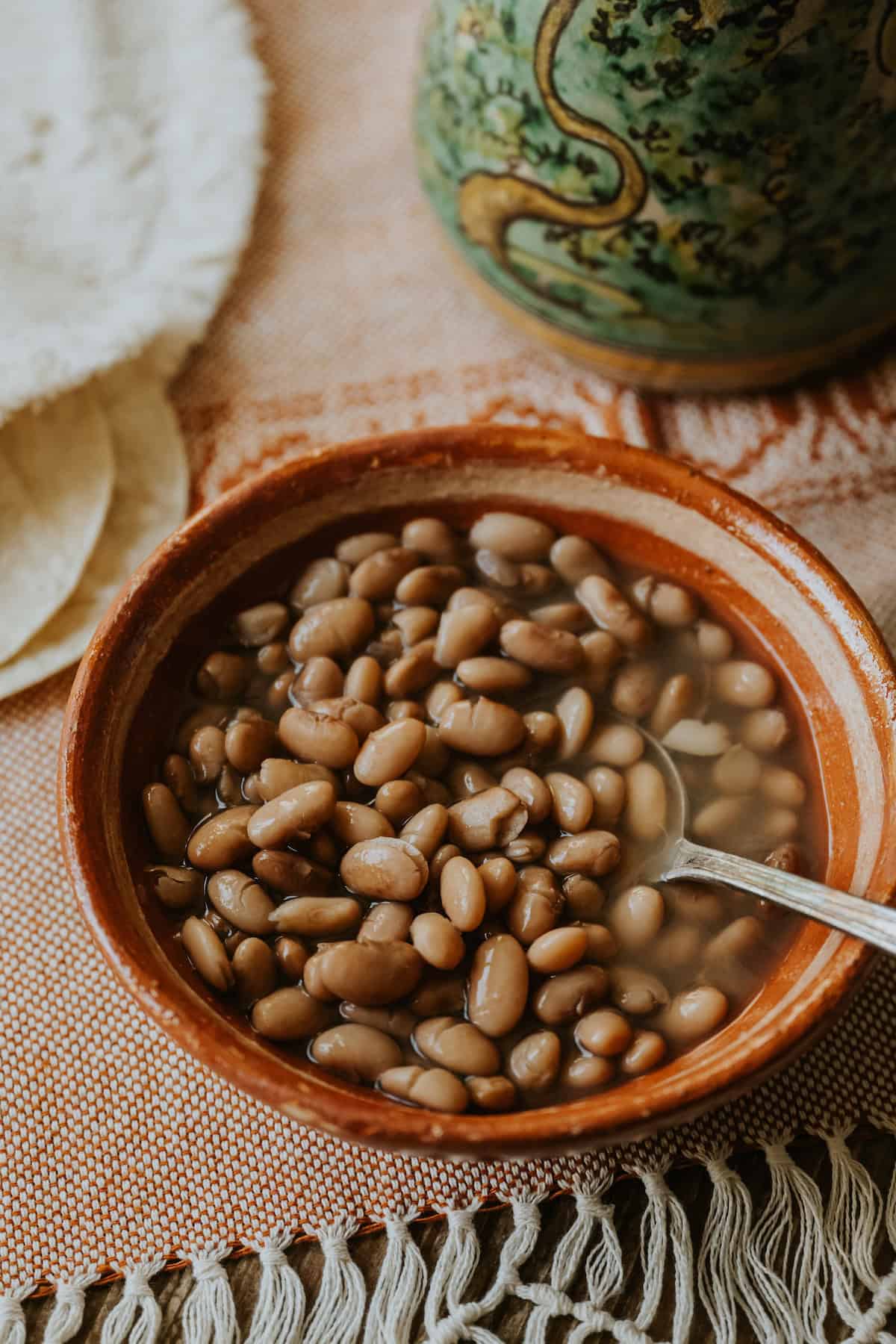
My mom always said, “If there are frijoles in the house then you have something to eat.” Truer words have never been spoken! In fact, the three things you could always find in our kitchen were homemade flour tortillas, salsa casera, and a simple pot of these frijoles pintos. And really, that’s all you need!
Featured In
This Frijoles de Olla recipe has been featured in sheknows.com: 16 Traditional Latin comfort foods that you need to make this fall.
What are Frijoles de la Olla?
Frijoles de la olla translates to “beans from the pot.” Traditionally, pinto beans were slow-cooked in a clay pot (known as an olla de barro) with nothing more than water and salt, and maybe with some onion and garlic tossed in for good measure. It sounds simple, but I promise—they’re amazing.
I love how pure and fresh they taste straight from the pot. As soon as they were ready to eat I would fill a large bowl with frijoles, add some fresh salsa, and scoop them up with homemade flour tortillas or corn tortillas. It is the perfect meal—yummy, satisfying, and excellent for when times are tight.
Frijoles de olla are also so versatile. These authentic Mexican beans can be eaten fresh from the pot, turned into creamy refried beans, or mixed in with homemade chorizo for a pop of spice and protein, just to name a few ideas. And, of course, they’re also perfect alongside all your favorite Mexican meals.
I realize not all American home cooks will have an olla (though if you want one, this is one of my favorites). Not to worry! I’ve included instructions for using a Dutch oven or Instant Pot below.
Ingredients & Equipment Needed
The complete list of ingredients, quantities, and instructions can be found in the printable recipe card below.
- Dry Pinto Beans – I love keeping dried beans on hand in the pantry. Not only are they cheaper than canned, they’re also way tastier! This recipe also works with other popular Mexican dried beans like mayocoba, pinquito, or black beans.
- Onion – Optional, but excellent for added flavor. I usually add half a white onion, but feel free to swap with a yellow onion. Feel free to use both onion and garlic for an added flavor boost.
- Salt – We’re going back to the basics, but we still need seasoning. Salt is added after the frijoles are cooked. If possible, use kosher salt or sea salt rather than iodized table salt, which can add a slightly bitter flavor.
- Water – Start with cool, fresh water so as not to shock the beans.
- Large Pot or Instant Pot – If you go for the stovetop method, I recommend using an enameled cast iron dutch oven or another heavy-bottomed option.
- Colander – Rinsing and picking through your dried beans is essential for removing dirt, grit, and pebbles. Grab a colander with small enough holes that the beans can’t pop through.

How to Make Frijoles de la Olla
Below I offer two methods for making these Mexican pinto beans—in a dutch oven or in an Instant Pot. Either way, the first three steps are the same:
Step 1: Measure & Sort. Measure out the beans. Spread the beans over your counter so you can look for beans that are broken, discolored, or shriveled and remove them. There will also be small stones or pebbles that should be sorted out of the beans during this phase. Discard all of the undesirable pieces.
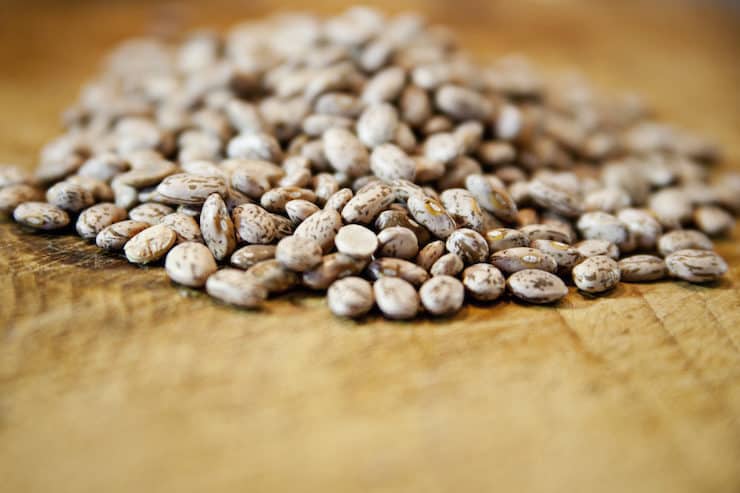

Step 2: Rinse. Place beans in a colander. Rinse the beans thoroughly with cool water.
Step 3: Soak. This step is not necessary, but your beans will be more plump and lighter in color, and, as my mom says, “mas bonitos.” Cover the dried beans with cold water by about 2 inches and soak for at least 1 hour or overnight before cooking. Drain and rinse before cooking using either method below.


Stovetop Method
Step 1: Bring to a Boil. Pour the drained beans into a large pot, and onion, if using. Add enough water to reach 3 inches over the beans, about 2 liters. Bring to a boil over medium-high heat.
Step 2: Simmer. Reduce the heat, cover, and simmer until the beans are tender, about 3 – 4 hours, adding more hot water as needed; the beans absorb liquid. Every pot is different, so check your beans after 2 hours. Most take 3 – 4 hours, but my Le Creuset only takes 2 hours.
Step 3: Season. Add salt about one hour before complete. Serve immediately, or refrigerate beans when cooled.
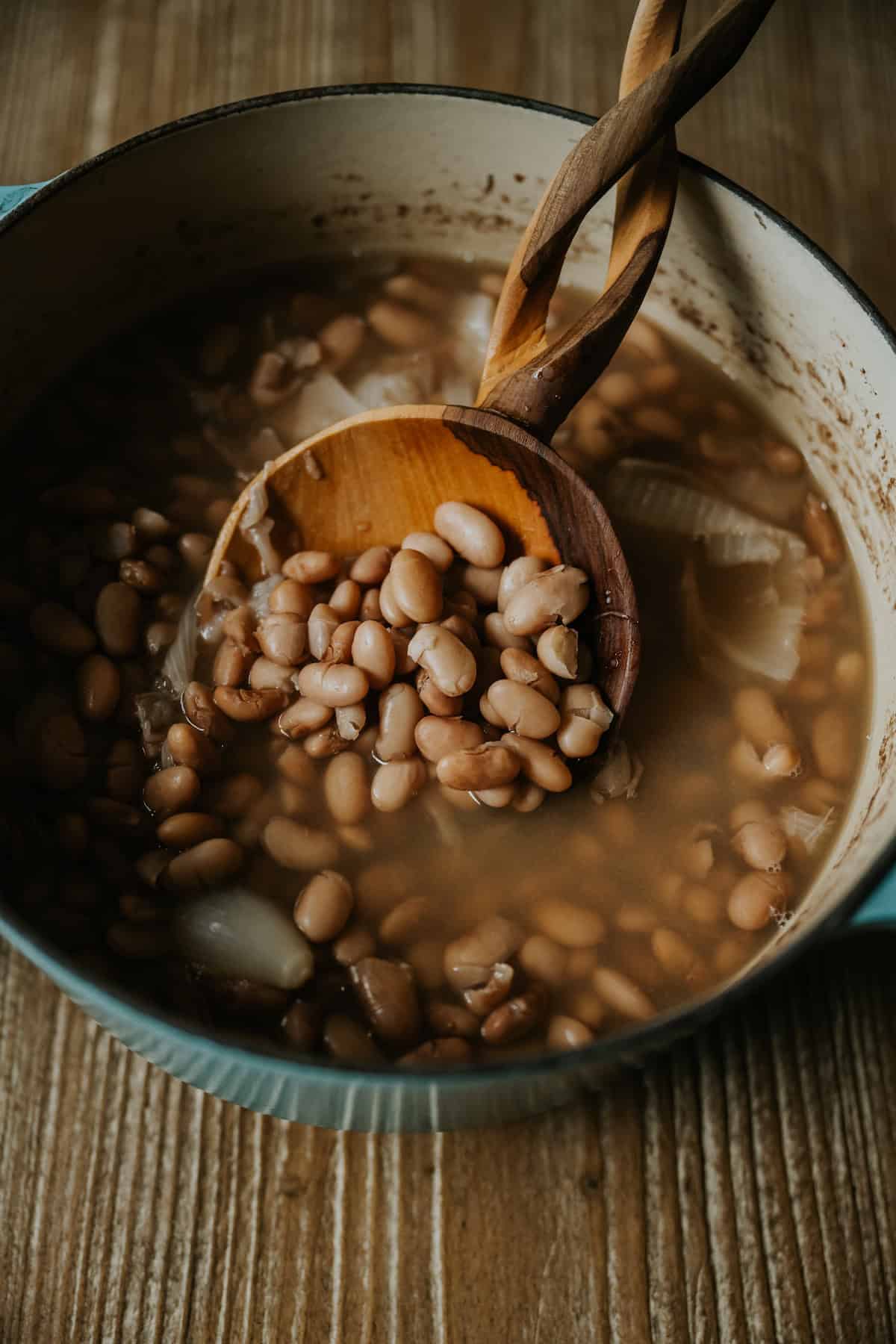
Instant Pot Method
Step 1: Put Everything in the Pot. Place dried soaked beans, salt, onion, and water (2 liters) in an Instant Pot. Seal the lid.
Step 2: Cook. Use “manual” setting for 30 minutes of pressure.
Step 3: Natural Pressure Release. Allow pressure to naturally release, approximately 30 to 40 minutes.
Step 4: Season beans to taste, then serve & enjoy!
Frequently Asked Questions
“Beans from the pot.”
It depends on several factors, including how old the dried beans are (the older they are, the longer they’ll take), whether or not you soaked them, how long you soaked them for, and the variety of beans you’re using. The method will also affect cooking time—a pressure cooker (e.g. Instant Pot) will be much faster than on the stovetop. Generally speaking, it could be anywhere from 2-6 hours if you make them in the traditional stovetop manner.
No, not necessarily, but I highly recommend you soak them for at least one hour to ensure beans are clean and plump when cooked.
Absolutely! These Mexican pinto beans will keep well in the freezer for up to 6 months.
Absolutely! I have detailed instructions on how to do so in the recipe card below. I prefer using the traditional stovetop method, as the bean broth becomes more concentrated and flavorful, the skins are less likely to split, and you can wait to add the salt. (More on that in the expert tips section.) That said, the Instant Pot is a godsend on nights when you need frijoles and you need them fast!
While my mom always made pinto beans, this recipe can also be used with black beans.
You have a few options—either continue to simmer the beans to let the liquid evaporate, spoon some out, or leave it as is and eat the beans like a soup. The bean liquid (known as “brodo” by bean fanatics) is very flavorful. Even if I scoop the beans out with a slotted spoon, I’ll often save the broth to make a soup later in the week.
Serving & Topping Suggestions
Whether eaten fresh from the pot or refried, these little morsels can create a slew of other recipes. Frijoles were the side dish of choice for Mexican breakfast recipes, lunch, and dinner when I was growing up.
One pot of these beans can evolve into so many other dishes. Some of my favorites include:
- Refrying them and making a vegetarian tostadas, molletes Mexicanos, huevos rancheros, or huaraches.
- Using them for chili con carne, frijoles charros, or your favorite soups.
- Adding bulk to chorizo breakfast burritos, vegetarian burrito bowls, or making vegetarian enchiladas.

Expert Tips & Tricks
- Wait to add the salt. Among the bean-loving community, there’s a hearty debate about when to salt your beans. One school of thought is to wait to add salt (and acid, for that matter) until the beans become tender. This helps ensure the beans remain whole, leaving a prettier presentation. Adding salt too early can also change the texture of the beans, making them a bit tougher. That said, if you’re going the instant pot route, add salt at the beginning—they’re likely going to have split skins anyway, and adding the salt too late means it won’t have time to penetrate the whole bean.
- Simmer, don’t boil. You want to bring them to a boil at first, but don’t let the beans boil for more than 10 minutes. Reduce the heat to low, so the simmer is barely bubbling. This will also ensure your beans turn out “mas bonitos.”
- Add HOT water. When adding more water, make sure it’s boiling hot water. Otherwise your beans may darken in color.
- Soak if you can, especially if they’ve been sitting on your shelf for an undetermined amount of time. Soaking does a few big things:
- Reduces cooking time considerably, especially if you leave them overnight.
- Ensures your beans cook evenly. If your bag of pintos has been hanging in your pantry for more than a year, they’ll be drier and will cook less evenly. Nobody wants crunchy frijoles! By soaking them first, they’ll plump up beautifully. NOTE: Because of this plumping action, make sure you give them plenty of water and space to expand.
- Decreases phytic acid, the *ahem* musical compound in beans. For what it’s worth, the more beans you eat, the less susceptible your tummy will be to phytic acid’s effects.
Storage & Heating Instructions
- Refrigerate: Frijoles de la olla can be refrigerated for up to 5 days.
- Freeze: They also freeze well for up to 6 months in these plastic containers—super handy for a last-minute dinner. Make sure you leave at least a ½ inch of headroom for the liquid to expand.
- Reheat: To serve leftover Mexican pinto beans, allow them to defrost overnight in the fridge. If you’re heating up a single portion, you can zap them in the microwave. Otherwise, simmer them gently for about 10 minutes until warmed through.
More Mexican Bean Recipes
If you make this recipe, please let me know! Leave a ⭐️⭐️⭐️⭐️⭐️ rating on this recipe below and leave a comment, take a photo and tag me on Instagram with #muybuenocooking.

Summarize & Save This Content On

Frijoles de la Olla Recipe
Ingredients
- 2 cups dry pinto beans
- ¼ onion, optional
- 1/2 teaspoon kosher or sea salt, or more to taste
- water
Instructions
- Measure out the beans. Spread the beans over your counter so you can look for beans that are broken, discolored, or shriveled and remove them. There will also be small stones or pebbles that should be sorted out of the beans during this phase. Discard all of the undesirable pieces.
- Place beans in a colander. Rinse the beans thoroughly with cool water for about 3 minutes.
- This step is not necessary, but your beans will be lighter in color and “mas bonitos” as my mom says: Cover the dried beans with cold water by about 2 inches and soak for at least 1 hour or overnight before cooking. Drain and rinse afterward.
Instructions for cooking the beans in a regular pot:
- Pour the drained beans and onion, if using, into a large pot. Add enough water to reach 3 inches over the beans, about 2 liters. Bring to a boil over medium-high heat. Cover and simmer until the beans are tender, about 3 – 4 hours, adding more hot water as the beans absorb liquid. Every pot is different and so check your beans after 2 hours. Most take 3 – 4 hours but I have a pot I love to cook my beans in because it only takes 2 hours.
- Add salt about one hour before complete. Refrigerate beans when cooled.
Instructions for Instant pot:
- Place dried soaked beans, salt, onion, and water (2 liters) in Instant Pot.
- Use “manual” setting for 30 minutes of pressure.
- Allow pressure to naturally release, approximately 30 to 40 minutes. Season beans to taste.
Video
Notes
- Reduces cooking time considerably, especially if you leave them overnight. Yay for faster eats and lower electric bills!
- Ensures your beans cook evenly. If your bag of pintos has been hanging in your pantry for more than a year, they’ll be drier and will cook less evenly. Nobody wants crunchy frijoles! By soaking them first, they’ll plump up beautifully. NOTE: Because of this plumping action, make sure you give them plenty of water and space to expand
- Decreases phytic acid, the *ahem* musical compound in beans. For what it’s worth, the more beans you eat, the less susceptible your tummy will be to phytic acid’s effects.
- Frijoles de la olla can be refrigerated for up to 5 days.
- They also freeze well for up to 6 months in these plastic containers—super handy for a last-minute dinner. Make sure you leave at least a ½ inch of headroom for the liquid to expand.
- To serve leftover Mexican pinto beans, allow them to defrost overnight in the fridge. If you’re heating up a single portion, you can zap them in the microwave. Otherwise, simmer them gently for about 10 minutes until warmed through.
Nutrition
Nutrition information is automatically calculated, so should only be used as an approximation.
This recipe is also published in the Muy Bueno cookbook.

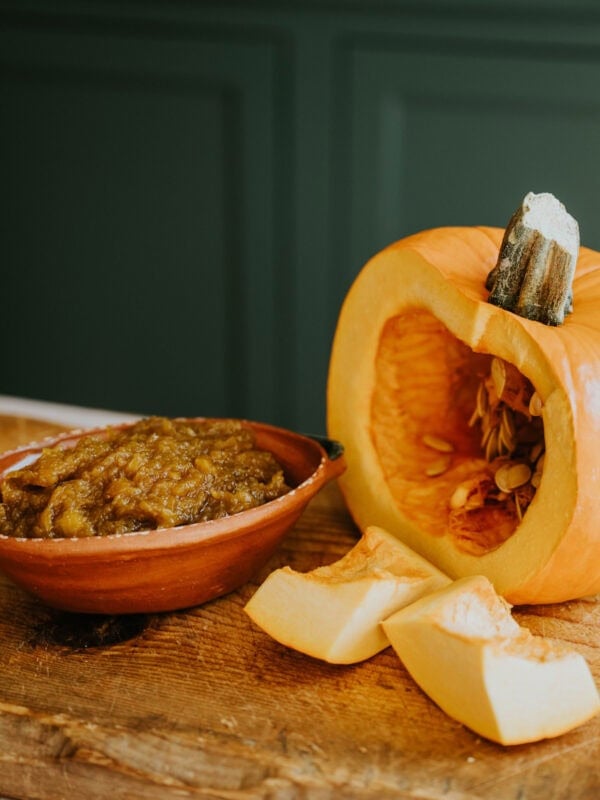

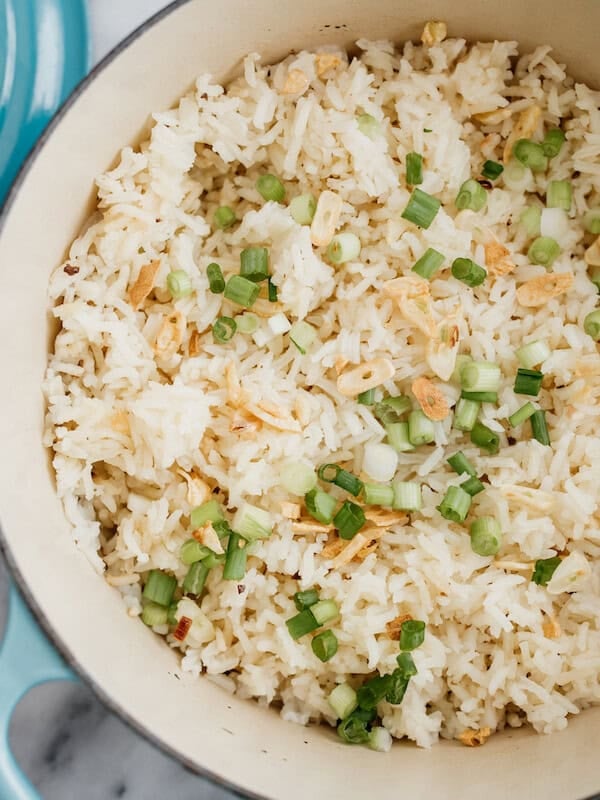









Can the beans be made in a crock pot? If so, what temp, low or high, and for how long?
Cover and cook on low for 7 to 8 hours.